There are fifteen methods of temporary contraception and two methods of permanent contraception and we will give you a brief overview of each of them.
Contraceptive Implant - The implant is approximately 40mm long and contains 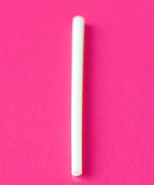 progestogen, a synthetic hormone which stops ovulation and thicken the cervical mucus and lining on the womb to prevent fertilisation. It is implanted under the skin of the upper arm and lasts for approximately three years. An implant can be removed at any point and does not have an impact on natural fertility.
progestogen, a synthetic hormone which stops ovulation and thicken the cervical mucus and lining on the womb to prevent fertilisation. It is implanted under the skin of the upper arm and lasts for approximately three years. An implant can be removed at any point and does not have an impact on natural fertility.
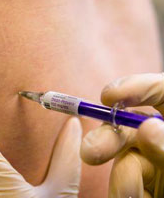 Contraceptive Injection - The injection works in the same way as an implant but offers contraceptive protection for between eight and twelve weeks. It also contains a progestogen and is useful for women who should not take contraception containing oestrogen's. It also does not interact with other medicines.
Contraceptive Injection - The injection works in the same way as an implant but offers contraceptive protection for between eight and twelve weeks. It also contains a progestogen and is useful for women who should not take contraception containing oestrogen's. It also does not interact with other medicines.
 Contraceptive Patch - The contraceptive patch delivers oestrogen and progestogen through the skin, (very similar to NRT patches). It should be applied to an area of the skin that is clean, dry and where the patch cannot be rubbed off. Each patch will last one week and during the month three should be applied with a one week break.
Contraceptive Patch - The contraceptive patch delivers oestrogen and progestogen through the skin, (very similar to NRT patches). It should be applied to an area of the skin that is clean, dry and where the patch cannot be rubbed off. Each patch will last one week and during the month three should be applied with a one week break.
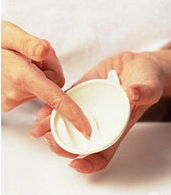 Diaphragms - This form of barrier contraception is made of latex or silicone and is a circular dome shape which covers the cervix. Diaphragms come in different sizes and they must be first fitted by a trained doctor or nurse to ensure the right size is prescribed. A diaphragm must be inserted before intercourse and left in place for at least six hours after.
Diaphragms - This form of barrier contraception is made of latex or silicone and is a circular dome shape which covers the cervix. Diaphragms come in different sizes and they must be first fitted by a trained doctor or nurse to ensure the right size is prescribed. A diaphragm must be inserted before intercourse and left in place for at least six hours after.
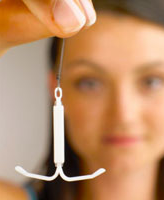 Intrauterine device (IUD) or Intrauterine system (IUS) - Also known as the coil, these are small T-shaped plastic or copper devices sometime containing progestogen, which is inserted into the womb by a trained health-care professional. It prevents sperm from surviving in the cervix, womb and Fallopian tube. It will also prevent a fertilised egg from implanting in the womb and offers protection between three and ten years.
Intrauterine device (IUD) or Intrauterine system (IUS) - Also known as the coil, these are small T-shaped plastic or copper devices sometime containing progestogen, which is inserted into the womb by a trained health-care professional. It prevents sperm from surviving in the cervix, womb and Fallopian tube. It will also prevent a fertilised egg from implanting in the womb and offers protection between three and ten years.
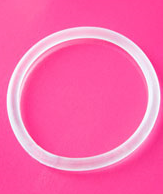 Vaginal Ring - This is a small soft plastic ring approximately 44mm thick and 5.5cm in diameter. It releases oestrogen and progestogen and should be inserted into the vagina on day one of a period and removed 21 days later. The ring should be disposed of and a new ring should be inserted after 7 days.
Vaginal Ring - This is a small soft plastic ring approximately 44mm thick and 5.5cm in diameter. It releases oestrogen and progestogen and should be inserted into the vagina on day one of a period and removed 21 days later. The ring should be disposed of and a new ring should be inserted after 7 days.
Natural family planning - Also known as the Rhythm method this method allows you to have sex without using contraception. It teaches you how to recognise when you are most fertile during the menstrual cycle by recording fertility signals, such as body temperature.
Female Sterilisation - This is a permanent method of contraception, which involves blocking or sealing the Fallopian tubes which are the tubes that link the ovaries to the womb. This ensure that eggs and sperm do not reach each other. This procedure is carried out in hospital under general anaesthetic. Sterilisation is very difficult to reverse.
Male Sterilisation - Also known as a vasectomy which is carried out under local anaesthetic and it blocks the tubes from the testicles to the penis that carries the sperm. This is a permanent procedure.
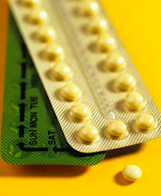 Contraceptive Pill - The contraceptive pill comes in two forms; the combined oral contraceptive pill (COC) and the progestogen-only pill (POP) or mini pill. Both of these prevent an egg from being fertilised, thereby preventing a woman from becoming pregnant. It can also be used to treat painful or heavy periods, premenstrual syndrome and endometriosis.
Contraceptive Pill - The contraceptive pill comes in two forms; the combined oral contraceptive pill (COC) and the progestogen-only pill (POP) or mini pill. Both of these prevent an egg from being fertilised, thereby preventing a woman from becoming pregnant. It can also be used to treat painful or heavy periods, premenstrual syndrome and endometriosis.
Did you know?
The two most commonly used forms of contraceptive are the combined & mini pills and condoms.
